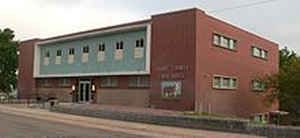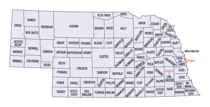Nebraska Counties
There is ninety-three counties in state of Nebraska. Despite the fact that Sarpy County contained the oldest settlement in the state, it was one of the last lands along the river to be recognized by law. Finally, on February 1, 1857, the land "where the cities meet the country" was officially created.Grant County, Nebraska
Grant County Education, Geography, and History
Grant County is a county located in the state of Nebraska. Based on the 2010 census, the population was 614, making it the fourth-least populous county in Nebraska and the ninth-least populous county in the United States. Its county seat is Hyannis. The county was founded in 1887 and named for Ulysses S. Grant, 18th President of the United States
Named: Named after President Ulysses S. Grant
Demographics:
County QuickFacts: CensusBureau Quick Facts
Grant County History
In the years that immediately
preceded the establishment of what today is Grant County, this area in the heart
of the Nebraska Sandhills became knows as a favorite hiding place for outlaws
and other fugitives from justice due to the wide open, sparsely settled terrain
and the lack of local government authority.
The cowboys that drove the first herds of Texas longhorns north along the old
Abilene and Chisholm Trails realized the Sandhills region was a perfect range
for cattle grazing. Rolling hills covered with hearty native grasses and
numerous natural lakes made the area a cattleman's paradise. But with the cattle
came rustlers and then other outlaws. Finally, in 1887, Gov. John Thayer
appointed R.M. Moran to restore law and order in the territory. Sheriff Moran
quickly broke up the gangs of outlaws who hid in the area and captured many
notorious characters.
Grant County, named after President Ulysses S. Grant, was created by the
Legislature on March 31, 1887. At the time the settlement of Whitman was
designated as the county seat. But Hyannis residents felt their town was more
centrally located and was better suited to serve in this role. They petitioned
for an election and were successful in their bid. When a delegation traveled to
Whitman to retrieve the county's records, residents of Whitman refused. The
delegation finally succeeded and for years carefully guarded the documents in
Hyannis while the bitter feelings continued.
The Kinkaid Act of 1904 is said to have brought an end to the days of free and
open range, as new settlers hoped to establish farms on their claims. These
farmers quickly became disheartened as winds blew away the tilled soil and crops
failed. They sold their claims to area cattle ranchers.
According to state statistics, less than a decade ago Grant County had a larger
number of cattle per square mile than any other county in the United States. The
importance of the Hereford cattle breed to this county is even depicted with a
mosaic picture that is mounted on the side of the courthouse in Hyannis.
Geography: Land and Water
As reported by the Census Bureau, the county has a total area of 783 square miles (2,030 km2), of which 776 square miles (2,010 km2) is
land and 7.0 square miles (18 km2) (0.9%) is water
Neighboring Counties
Bordering counties are as follows:
- Cherry County (north)
- Hooker County (east)
- Arthur County (south)
- Garden County (west)
- Sheridan County (northwest)
Education







